















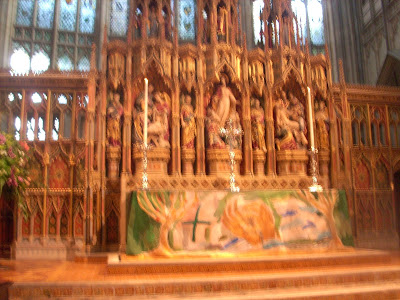
 ____________________________________________________________________________
____________________________________________________________________________Given that the stories of so many of the Lives of Gwynlliw's family were written down and detailed by the monks of Gloucester , to whom St Woolos was given after the Norman Conquest. I thought I would podcast and blog from this glorious building.Details of the history of the Abbey are from the Abbey's own website. Episodes of Dr Who and Hrry Potter have been filmed there. So in honour of the monk who wrote down all the histories , here are some details about the Abbey from the website of Gloucester Cathedral and its development
In Saxon Times
Gloucester Cathedral's history goes back a long time. In 681 King Ethelred gave Osric permission to found a monastery in Gloucester in honour of St. Peter. In 1048, A few years before the Norman Conquest of 1066, the site was used by Aldred, bishop of Worcester, to found a Benedictine Monastery.
The city of Gloucester being an important royal city at the time. William the Conqueror found the monastery in a state of decay and he appointed the first Norman abbot, Serlo, in 1072. Serlo started major rebuilding work in 1089 that lasted until he died in 1104. The abbey church he built was consecrated in 1100. When Serlo died, in 1104, h succeeded by Prior Peter and during his reign, the abbey church was given many donations of land. One of these being Robert Curthose, William the Conqueror's eldest son. An effigy of Robert can be seen in the Cathedral. The abbey also became an important Benedictine house in this century.
The Cloisters and 'Harry Potter'
The cloisters lie to the north. This may have been because of a lack of open space to the south. The cloisters may have been rebuilt between the middle and late 14th century and contain the first fan vaults to be seen in Britain. Fire played its part in the development of the abbey as the original Norman church had a wooden roof and was under constant threat.
Death of Edward II
The abbey church was under constant financial threats as the cost of maintaining and adding to the building was so high. In 1284, John de Gamages became abbot at Gloucester and through his farming knowledge increased the stocks of sheep owned by the abbey and returned a profit. After de Gamages reign things again took a down turn, until the horrible death of King Edward II at Berkeley Castle. The King was buried at Gloucester and the number of pilgrims that visited the abbey gave it a much needed boost. Gloucester Cathedral was used as a location for Hogwarts in the Harry Potter film ‘Harry Potter and the Philosopher's Stone.’ And will feature again in further films .
Re-founding of the Monastery under Aldred
In 1048 Aldred, Bishop of Worcester refounded the monastery which had first been founded by Osric in 681. In 1072, in Norman times, Abbot Serlo took over. He was William the Conqueror’s chaplain and he started major rebuilding work, dying in 1104, after he had begun work on a crypt.The Abbey Church of St Peter at Gloucester was dedicated by Samson, Bishop of Worcester, Gundulph of Rochester and Harvey of Bangor.Robert Curthose, eldest son of William the Conqueror died in captivity in Cardiff Castle, where he had been locked up , since being efeated by his brother in 1106. Robert of Normandy was buried in the Abbey Church, where a brightly coloured effigy to him lies even today.
Coronation of Henry III
Henry III was crowned King at St Peter’s Abbey, Gloucester in 1216 October 28th ( a year after his father King John had signed the Magna Carta at Runneymede). He was crowned by Peter des Roches Bishop of Winchester. The Earl of Pembroke , Earl Marshal of England was declared Regent. The Earls of Pembroke were all buried at Tintern Abbey.
Henry III donated one hundred and ten oaks from the forest of Dean to help in repair work at Gloucester Abbey church in 1232.
A Royal Abbey Church
Royal patronage and popular devotion led to funds flowing into the abbey, and these enabled the magnificent remodelling of the east end to be carried out in the very latest “Perpendicular” style.
In the 15th century further building work included the remodelling of the west end, the building of the south porch and of the present tower and finally, towards the end of the century, the present Lady Chapel.
The Dissolution and a New Foundation
Following from his desire to marry Anne Boleyn, Henry VIII ordered the monasteries to be dissolved and the last Abbot handed over the Abbey in 1540. The abbey buildings became Gloucester Cathedral, the seat of the new Bishop of Gloucester in Henry’s own, newly created Church of England in 1541. The monks were put out on pensions. Some starved or were taken in by friends, others made their way to Douai in France , where the Great Mission began. Many many clergy died in this event and their numbers never recorded but they were substantially , for more than were executed in the reign of Mary, Henry’s daughter, who confined herself to executing people who had had a hand in bringing about the downfall of her mother, or were preaching sedition against her person.
Bishop Hooper and Mary I
Mary I was Queen from 1553 to 1558; born 18 February, 1516; died 17 November, 1558. She was the daughter and only surviving child of Henry VIII and Catherine of Aragon (Daughter of Ferdinand and Isabella of Spain). Cardinal Wolsey was her godfather, and amongst her most intimate friends in early life were Cardinal Pole and his mother, the elderly Countess of Salisbury, put to death in 1539 and now beatified.
Childhood
We know from the report of contemporaries that Mary in her youth did not lack charm. She was by nature modest, affectionate, and kindly. Like all Tudor princesses she had been well educated, speaking Latin, French, and Spanish with facility, and she was in particular an accomplished musician. She was forcibly separated from her mother, when her father callously decided to dispose of her to marry Anne Boleyn and founded his own church. Cranmer ,Ridley and Latimer, who had lectured and caused anguish to her mother and were executed and so were Bishop Hooper and others who were focal points for Protestant plotting .So Mary decided there was nothing more she could do than to enact the statutes of heresy against them, to make her own throne more stable.
The INsecurity of Mary Tudor's Throne
Unfortunately this heresyand sedition was widespread and having started with the ringleaders, who preached against her, and her undoubtedly unpopular marriage, she became alarmed and regrettably was forced to carry on rooting out the troublemakers against the religious peace of her realm. Deprived of love as a child, persecuted for her Catholic beliefs, plotted against by Somerset,( in the Lady Jane Grey conspiracy), she was very insecure, particularly as she was virtually abandoned by her Spanish husband. This insecurity forced her to rely upon her advisors, and burning was the traditional way of dealing with heretics-already employed extensively by Henry VIII and Edward VI and later by Elizabeth with much greater ferocity and in greater numbers.
Bishop Hooper was burned at the stake at Gloucester for heresy and sedition against the Queen and a monument stands outside. For that time, the death of poor Bishop Hooper was a political neccessity , and very regrettable. It was natural for heretics to be dealt with in this way in this period, but still very sad. Unfortunately, as a man in public office, he would not stop preaching against the Queen.
With contemporary eyes……..
With contemporary eyes of course,all these events were very cruel, but even well into Stuart times, ‘witches’ were burned and persecuted , priests were hung drawn and quartered just for being priests and general religious instability remained. Such people were executed out of political expediency, to shore up political security. It might also be said, that the lust of Henry V III was responsible for all these events and the death of so many.
Charles I and Cromwell
in the 1620’s Bishop Miles Smith and his Dean, William Laud had many disputes over how the new church should function The ‘umbrella’ nature of Elizabeth’s compulsory Church of England resulted in many battles over what the nature and style fo the Church of England should be and views were often profoundly different.Catholics and Puritans were heavily fined if they did not attend this church and Priests could be hung drawn and quartered if found to be ministering to their flocks. These Priests, trained at Douai and Saint Omer were often sons of local people whom they returned to serve. Titus Oates was part of a Presbyterian faction trying to influence the Church of England’ and before he was executed for his lies, managed to convince the government of a ‘Popish Plot’ which never existed. Yet 120 priests, some over 80 years of age were hung, drawn and quartered in this wave of persecutions (I reported on the John Kemble pilgrimage a while ago)
Then under Oliver Cromwell there was a move to demolish the cathedral building altogether (it was saved by the intervention of the mayor and burgesses of the City of Gloucester).
Restoration of Charles II into the Present Day
With the restoration of the monarchy (after the civil wars and Commonwealth period) in 1660, the Church of England Dean and Chapter resumed the running of the St Peter’s Abbey Church as new Cathedral and that is how it is managed today. The King’s School occupies part of the Abbey Buildings on a statute of Henry VIII. It was always a famous school, even in monastic times.
Throughout the 18th, 19th and 20th centuries they have carried out repairs and conservation work rather than rebuilding or remodelling the building.




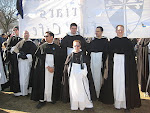



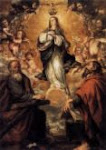


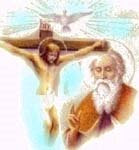























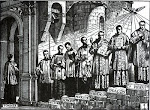


















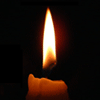









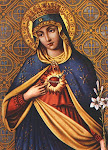



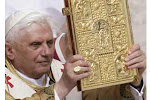














No comments:
Post a Comment